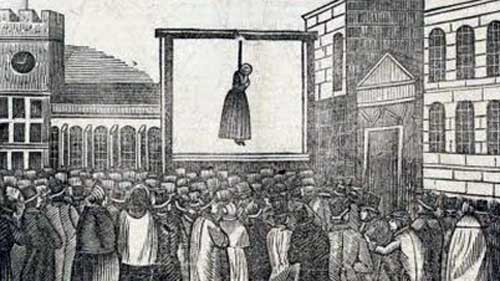Poison was the preferred method of murder for 19th century Lincolnshire-born serial killer Catherine Wilson, says L.H. DAVIES

A trained nurse, it could never be said that it was Catherine Wilson’s vocation was to care for the sick and needy. Instead she favoured doing away with those who entrusted their lives to her.
The 19th century was a time when poison (despite having to be signed for) was infinitely easier to access and with post mortems not yet being obligatory those who chose deadly toxins to terminate their victims, found it a great deal easier to get away with their crimes without raising too much (if any) suspicion.
Born in 1822, in Boston, Lincolnshire, very little is known of the early life of Catherine Wilson, other than that her upbringing within a poor family led her to become a household servant. Eventually, in 1853, Wilson became housekeeper to a retired mariner, Captain Peter Mawer.
Casting herself as friend and eventually nursemaid to the aging Captain, Catherine Wilson made herself a fundamental part of the household and in so doing, successfully became the beneficiary of Captain Mawer’s will.
Colchicine was the chosen poison
It is thought that Wilson discovered what would become her Modus Operandi within the Captain’s medicine cupboard: Colchicine. A vegetable poison, which in high enough doses can kill a human.
Not long after being made Mawer’s beneficiary, the Captain died of exhaustion, following several days of agonising pain and vomiting.
The doctor attending to Captain Mawer following his death recorded his end as one of accidental death. It was his conclusion that the former mariner had been in such great pain he had accidentally taken an overdose of his medicine.
Following Mawer’s death, Wilson moved away from Lincolnshire, heading south to the capital. In London, Wilson met up with a man named James Dixon; he became her lover. Using her newly acquired inheritance, Wilson and Dixon approached the wealthy Mrs Soames for accommodation.
Passing themselves off as brother and sister so as to be more socially acceptable, the pair moved in to number 27 Alfred St, Bedford Square. Here Wilson began to become friendly with Mrs Soames, becoming very close to her and discovering that the lady was herself about to inherit.
With this in mind and becoming increasingly tired of her drunken and occasionally violent lover, Catherine Wilson decided it was time to get rid of him. Only a short time later, Dixon fell ill and died.
Mrs Soames was ‘kind-hearted’
Now, apparently having suffered the loss of her brother, Wilson found Mrs Soames to be increasingly kind-hearted and attentive and eventually Wilson decided it was time to end her life. Apparently, however, Mrs Soames was much hardier than Wilson anticipated.
She resisted the poison well, and even found herself beginning to feel fine again. She credited Wilson’s care with her remarkable recovery, and readily received a further dose of medicine. Sadly within hours she was crying out in pain once more and died soon after.
Wilson forged an I.O.U presenting it to the family of Mrs Soames forcing them to present her with money.
Sometime later, though little is known of the exact circumstances surrounding their meeting and friendship, Wilson had befriended a woman by the name of Jackson. It was recorded that she withdrew £120 and soon after fell ill and died. The money was never traced.
In 1859 and with new lodgings, Wilson regained her acquaintance with a Mrs Anne Atkinson who was in fact the aunt of Wilson’s now deceased lover, James Dixon.
The Atkinson’s were a fairly well off couple who resided for the most part in Kirkby Lonsdale in Cumberland. Mr Atkinson was a tailor, his wife Anne, a milliner and dressmaker.
Having recently met up with Wilson on a shopping trip, (where £50 of Anne’s money had been stolen) Anne was only too happy to accept her friend’s invitation for her to stay with her on her next visit to the capital.
Once a year, Anne would travel south to London on business and so it was that in October of 1859, Anne Atkinson made the fatal decision to reside with her friend.
Catherine Wilson had a ‘repulsive personality’
By this point, Wilson was once again short on money and in debt with her land lady, who was quoted as saying at the eventual trial of Catherine Wilson that Anne Atkinson was of a jolly nature and quite the contrast to Wilson’s own repulsive personality. Carrying £110 with her, Anne had left Kirkby Lonsdale in good health, yet on the fourth day of her visit her husband received a telegram to inform him that his wife was dangerously ill. By the time he arrived, his wife had slipped into a coma. She never regained consciousness and died shortly after.
Wilson played down the disappearance of Anne’s money by informing her husband that she had been robbed on her journey down and having recalled the theft of the £50 some months before, he was satisfied that Catherine Wilson was not to blame. Indeed she even went so far as to convince him to block a post mortem on Anne’s body by stating that her friend had voiced her immense dislike of the idea and once again, Wilson succeeded in her crime.
Three years later, Catherine Wilson had found employment as the live-in nurse to Mrs Sarah Cornell. After a long period of what she deemed to be excellent care, Sarah Cornell changed her will in favour of her care-giver. Now, once again, Wilson was ready to strike, yet it would be this attempt at murder that would be her eventual downfall.
Concocting a calming draught for her patient, Wilson watched as her next victim took a mouthful; unfortunately for Wilson the draught was so strong that Sarah spat it back out, complaining that the liquid burned her mouth. It was later discovered that the draught she spat onto the carpet burned through the fabric, and once Wilson realised she had been discovered, she fled.
On testing the liquid Sarah Cornell had been offered, it was discovered that it contained high levels of sulphuric acid. When she was later caught, Catherine Wilson was charged with attempted murder.
She said she didn’t know it was poison
Her defence at trial was that she had not known that what she had presented to her patient was a poison containing acid and that the pharmacist had clearly given her the wrong bottle. Without enough evidence to satisfactorily convict her, Catherine Wilson was found not guilty. Her freedom, however, was short lived.
She was arrested immediately afterwards. Suspicion had been raised by the Cornell case and investigations into previous deaths with which she was associated had been conducted. She was charged with the murders of seven patients, though she went on trial for only one. The murder of Mrs Soames.
On September 25th 1862, before Mr Justice Byles, Catherine Wilson was found guilty of the murder of Mrs Soames. She was hanged on October 20th 1862.


